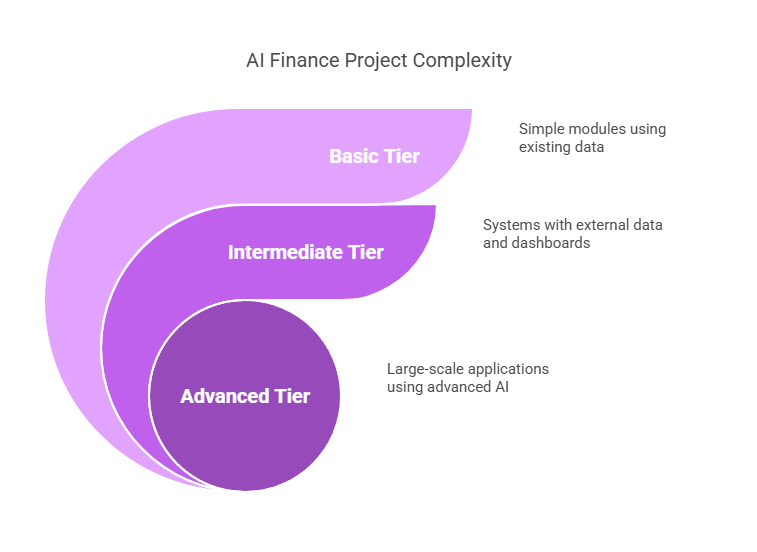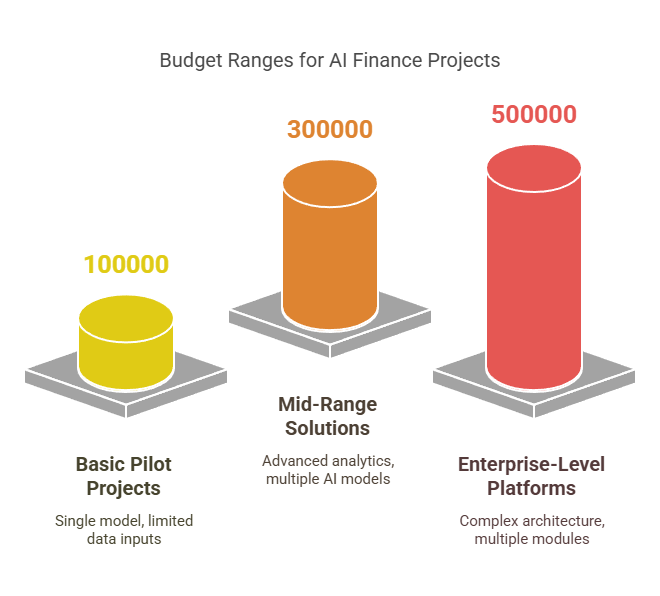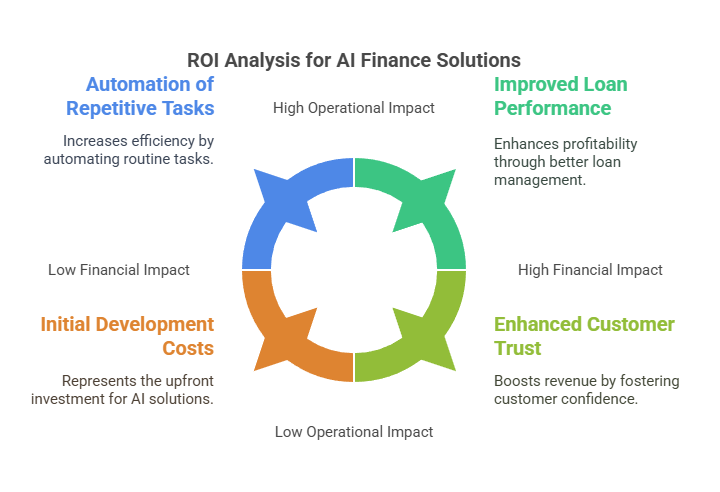In 2025, building financial software with AI capabilities will set you back anywhere from $50K for no-frills applications to a whopping half-million for sophisticated enterprise systems. What drives this massive price gap? Factors like technical complexity, data handling needs, and your development team’s AI chops all play crucial roles. Many executives find themselves utterly baffled when trying to budget for these projects, leaving their financial planning in limbo. The cost to build AI Finance Software is a multifaceted topic, and understanding the diverse components that influence expenses is critical for budgeting confidently and achieving a solid return on investment.In this article, we’ll explore how the AI finance software development cost evolves based on project scope, technology stacks, regulatory compliance, data demands, and a host of other considerations. We will break down how you can plan your budget, what goes into training cutting-edge AI models, and why maintenance and updates often become some of the most overlooked cost drivers. Let me explain this further: By grasping these specifics, you can minimize surprises and engineer a well-defined strategy for launching a robust financial AI solution.
Defining AI Finance Software and Its Benefits
AI finance software refers to intelligent applications designed to automate or augment financial operations, including tasks like fraud detection, robo-advisory, predictive analytics for market movements, and automated loan approvals. Whether you’re aiming to build AI Finance Software to improve credit scoring or to create AI Finance Software that forecasts market fluctuations, these solutions rely on machine learning models and, in some cases, deep learning technologies. They process massive volumes of structured (numbers, dates) and unstructured (text, images) data.
From a business standpoint, the value is tremendous. Imagine an AI system that can automatically categorize hundreds of expense entries in seconds or predict future revenue streams with astonishing accuracy. This is no longer a distant vision. With the right solution in place, an organization can cut human error, reduce operational costs, and gain a competitive edge in dynamic financial markets. Yet, the AI software development pricing can vary widely, largely because every business’s requirements differ in scale and functionality.

Key Factors Influencing the Cost to Build AI Finance Software
You might wonder, “What truly dictates the financial AI application development cost?” The answer is… a combination of many elements, some quite obvious and others easily overlooked. Below are the main contributors to your overall budget.
1. Project Complexity
AI finance projects can range from simple predictive analytics tools for basic forecasting all the way to intricate, fully automated decision-making systems. A small pilot solution that handles only one type of prediction (like daily cash-flow analysis) naturally tends to cost less than a platform implementing advanced features such as real-time trading analytics and robo-advisory functions.
Complexity Examples
- Basic Tier: A straightforward AI module that uses existing spreadsheets or SQL databases for data.
- Intermediate Tier: A more elaborate system integrating external data sources and offering real-time dashboards.
- Advanced Tier: A large-scale application deploying recurrent neural networks or cutting-edge deep learning models for multiple tasks (fraud detection, asset pricing, compliance audits, etc.).

The more advanced the requirements, the greater the AI finance software development cost in terms of not only initial creation but also ongoing monitoring and refinements.
2. Choice of Technology Stack
The frameworks, libraries, and cloud-based technologies that power your AI capabilities are at the center of software architecture. For example, one may host the application on a public cloud provider such as AWS or Azure after choosing PyTorch or TensorFlow for deep learning.Each choice affects your cost to build AI financial software, primarily due to potential licensing fees, infrastructure subscriptions, or specialized expertise.
If your organization opts for a fully managed serverless environment, you may reduce overhead for spinning up servers. But you might spend more on data storage and pay-as-you-go usage fees. Conversely, a custom on-premises setup could require costly hardware procurement but allow more direct control over security and compliance.
3. AI Model Training and Data Preparation
Training advanced financial AI models typically requires a large volume of high-quality data. Gathering and cleaning that data can be time-consuming and complex. Data wrangling often takes up to 80% of a data scientist’s effort. This implies that you may need to engage or hire qualified data engineers, algorithm experts, and subject matter experts.
Furthermore, model training occasionally calls for specialized technology, like as GPUs, which might result in extra capital costs or cloud computing fees. It is advisable to account for these expenses early on since they have a direct impact on the price of developing AI finance software. Actually, smaller teams often underestimate the budget needed for robust data cleaning and model fine-tuning.
4. Regulatory Compliance and Security
A lot of regulations apply to the finance industry. Adding security features to every tier of your solution is necessary to comply with regional regulations like the CCPA in California, the GDPR in Europe, or the norms of regional financial regulators like the Monetary Authority of Singapore. Secure APIs, role-based permissions, access control systems, data encryption, and regular audits can all be necessary for compliance.
Naturally, this adds to the AI software development pricing, because compliance experts, cybersecurity specialists, and thorough testing all come at a cost. However, disregarding compliant design may later lead to even more costly dangers, such as penalties, harm to one’s reputation, or project rollbacks.
5. Ongoing Maintenance and Updates
Developing and releasing an AI-powered financial software is just the first step.Models need continuous retraining, especially those that rely on market patterns. Software libraries and cloud services receive frequent updates. Unexpected changes in regulations may require you to modify your strategy. Budgeting for upkeep is crucial because of these ongoing changes. You run the risk of your AI tool eventually being erroneous or non-compliant if you don’t devote enough resources to it.
The cost of maintenance might quickly increase, especially if the model requires frequent recalibrations. And we all know how quickly data can shift in the financial world (yesterday’s assumptions may not hold tomorrow!). Therefore, your AI finance software development cost forecast should factor in those ongoing improvements.
Common Budget Ranges for AI Finance Projects
Predicting an exact cost to build AI Finance Software can be tricky. However, typical budgets generally fall into three rough categories:
- Basic Pilot Projects (Approx. $50,000 to $100,000)
- Single AI model with limited data inputs.
- May rely on basic machine learning algorithms and standard cloud hosting.
- Mid-Range Solutions (Approx. $100,000 to $300,000)
- Multiple AI models and more advanced analytics.
- May incorporate neural networks and advanced data pipelines.
- Includes dedicated DevOps and moderate compliance measures.
- Enterprise-Level Platforms ($300,000+ to $500,000+)
- Complex architecture with multiple modules (fraud detection, compliance checks, predictive analytics).
- Heavy data requirements across many sources and real-time dashboards.
- Stringent regulatory needs, advanced machine learning, and possibly deep learning or agentic AI.

These ranges can expand or contract based on market conditions, talent availability, and how quickly you want to scale. In addition, different vendors may offer flexible payment models like monthly retainers, fixed-cost packages, or time-and-material estimates. Each approach can influence the AI software development pricing you ultimately end up with.
Practical Steps to Create AI Finance Software for 2025
- Identify Your Use CasePinpoint a business need that AI can address—maybe automating underwriting processes or detecting anomalies in expense reports. Clarity here helps you avoid building features you don’t actually need.
- Conduct a Feasibility StudyAnalyze your data quality, existing systems, and compliance frameworks. Consult subject matter experts to estimate your AI software development pricing more accurately.
- Assemble a Skilled TeamEngage data scientists, ML engineers, financial domain experts, and software developers. Having a multi-disciplinary team ensures all aspects of the project receive proper attention.
- Prototype RapidlyStart with a Minimum Viable Product (MVP). This pilot can test core features before you invest deeply. That way, you quickly see whether your AI logic or data strategy needs tweaking.
- Develop AI Finance SoftwareImplement your final architecture, ensuring security, compliance, and performance. This includes setting up the training environment (cloud-based or on-premises), integrating external data feeds carefully, and establishing robust DevOps practices for continuous deployment.
- Validate and DeployMove your finalized model into a staging environment to test it thoroughly. Once validated, deploy to production, but keep close tabs on performance metrics such as accuracy, latency, and user engagement.
- Monitor and OptimizeCollect real-world metrics that show how well your AI system is functioning. Are the forecasts accurate? Is the fraud detection rate improving over time? Retrain and refine as needed.

Planning for Return on Investment (ROI)
Evaluating return on investment for AI finance solutions involves looking at both tangible and intangible gains. Tangible benefits include reduced staffing costs (through automation), faster and more accurate financial decisions, decreased fraud losses, and better loan performance. Intangible benefits can be improved customer trust and brand image.
When analyzing ROI, it’s wise to factor in:
- Initial Development Costs: The up-front investment for building the solution.
- Monthly or Yearly Operational Expenses: Includes hosting fees, data subscription charges, and staff salaries.
- Potential Revenue Increases: Informed financial decisions often lead to increased profitability or new product lines.
- Opportunity Cost: The time and money saved by freeing staff from repetitive or manual tasks.

ROI calculations can sometimes take a year or more to demonstrate positively in the financial sector. Be prepared for a measured approach, especially if your AI system deals with complex tasks like credit underwriting or large-scale market analysis.
Example Cost Breakdown Table
Below is a sample cost breakdown that illustrates how the cost to build AI Finance Software might be distributed across different segments. This table is purely illustrative; actual figures can vary widely:
| Segment | Estimated Cost Range | Notes |
|---|---|---|
| Data Acquisition & Preparation | $10,000 – $50,000 | Depends on volume, data sources, and data cleaning complexity |
| AI Model Development & Training | $15,000 – $100,000 | Factoring in GPU usage, data scientist hourly rates, etc. |
| Compliance & Security Measures | $5,000 – $30,000 | May need specialized consultants for financial regulations |
| Cloud Infrastructure & Hosting | $10,000 – $50,000 (annual) | Scales with usage; can spike if data volumes are large |
| Front-End & User Interface | $5,000 – $40,000 | Includes design, UX, and web/mobile development |
| Maintenance & Updates | $5,000 – $50,000 (annual) | Ongoing costs for new regulations, data or model updates |
| Project Management & QA | $3,000 – $20,000 | Oversees coordination, testing, and smooth delivery |
Addressing Common Misconceptions
One widespread misconception is that you need a massive data repository to gain any advantage from AI. In reality, you can still succeed with moderate datasets by leveraging transfer learning or well-curated external data sources. Another common belief is that your AI solution will be a one-and-done project. In finance, especially, you must plan for continuous enhancements as regulations, consumer behaviors, and market trends evolve.
A less obvious consideration involves ethical AI usage. With finance apps, any discriminatory bias in model outputs can lead to serious reputational damage (for instance, incorrectly denying credit to certain groups). It’s important to incorporate fairness and transparency checks, which can add a few more lines to the final cost to build AI Finance Software but will save your business potential crises down the line.
Conclusion and Next Steps
If you’re evaluating how best to build AI Finance Software in the coming year, take time to map out your goals, data readiness, and long-term compliance strategy. While the AI finance software development cost can initially seem overwhelming, the payoff in operational efficiency, faster financial decision-making, and improved customer trust generally justifies the investment. In our experience, organizations that implement AI in a methodical, step-by-step manner—beginning with an MVP and gradually expanding—see the highest returns.
If you want to future-proof your product, consider investing in advanced techniques like deep reinforcement learning or blockchain-based data integrity solutions. Yet, keep in mind that these additions will raise the AI software development pricing, so balancing innovation with practicality is key. Businesses that do this well often end up with a robust competitive advantage in the marketplace.
And what if you need an ally with hands-on know-how for your project? Feel like you could benefit from more in-depth conversation about encryption protocols, compliance rules, or better ways to develop AI Finance Software? We’re here to help.
About BuildFuture
I’d like to refine that point made above about project complexity: sometimes simpler data patterns yield significant insights without overshooting budgets. At BuildFuture, we’ve guided clients through both small-scale proof-of-concept projects and large enterprise builds. We aim to deliver solutions that align with your financial industry needs, using the latest machine learning tools, expert data engineering, and best-practice security methods.
We are proud to offer strategic consultation, end-to-end solution development, and ongoing maintenance for those looking to create AI Finance Software they can trust. Connect with us to learn how our team can tailor a solution that suits your corporate objectives, whether you’re a budding startup or an established enterprise.
Need more insights into the cost to build AI Finance Software or do you have lingering questions about compliance factors? Reach out to us, and let’s chat about paving the way for your AI-driven financial future.




